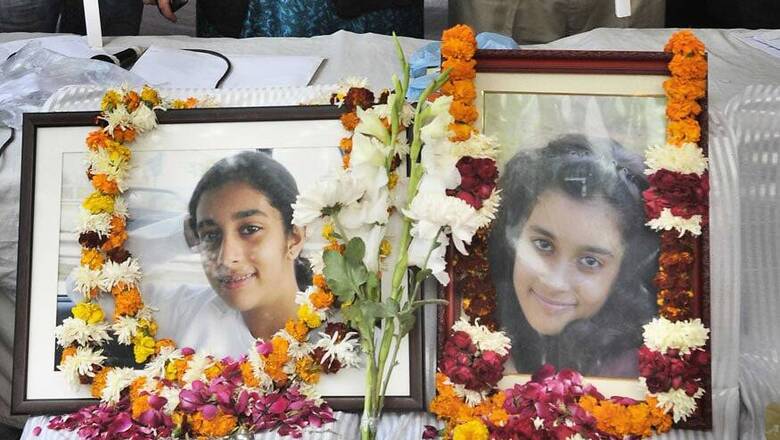
views
New Delhi: The 263-page verdict by the Allahabad High Court in the Aarushi-Hemraj double murder case has at many instances censured the CBI for manufacturing evidence to put the Talwar couple in the dock. Dealing with a specific piece of crucial evidence, the division bench went on to the extent of underscoring that the investigating agency “connived” with a forensic lab to secure conviction for Rajesh and Nupur Talwar.
At one point, the HC even held that a “clinching evidence” was on record to indicate Krishna, a clinic attendant of Rajesh Talwar, was in the house when Hemraj was killed.
“It is on account of the aforesaid fact that Hemraj’s blood got embossed on the hair of Krishna which in turn got embossed on his purple colour pillow cover which was admittedly seized from the Krishna’s premises,” concluded the HC.
In several other paragraphs of the judgment, the judges suggested clearly that needle of suspicion should point towards Krishna since there were specific evidence on record to note that he was in the house when the double murder took place.
So why did the HC stop here? Given the degree of certainty expressed by the HC about Krishna’s presence in the house when Aarushi and Hemraj were killed, questions are bound to be raised what prevented the division bench to act in its authority under the Code of Criminal Procedure (CrPC) to make sure the guilty is punished for the grotesque crime and the victims — be it the parents, other family members of the deceased, or the society as a whole — attain a sense of closure and complete justice.
In Stirland Vs Director of Public Prosecutor, 1944 – a judgment which has found resonance in State of UP Vs Anil Singh, 1988 and in a catena of other verdicts by the Supreme Court, it was ruled that a judge does not preside over a criminal trial, merely to see that no innocent man is punished. “A judge also presides to see that a guilty man, does not escape. Both are public duties,” it had held.
Considered a torchbearer of human rights in the Indian judiciary, Justice Krishna Iyer had also emphasised in a series of his judgments that “the judicial instrument has a public accountability” and that “the excessive solicitude reflected in the attitude that a thousand guilty men may go but one innocent martyr shall not suffer is a false dilemma”.
One of the finest legal minds and champion of human rights, Justice Iyer had in Inder Singh VS State (Delhi Admin), 1978, pointed out that if a case is proved perfectly, it is argued that it is artificial; if a case has some flaws, inevitable because human beings are prone to err, it is argued that it is too imperfect.
“One wonders whether in the meticulous hypersensitivity to eliminate a rare innocent from being punished, many guilty persons must be allowed to escape. Proof beyond reasonable doubt is a guideline, not a fetish,” emphasised the verdict.
In Gurbachan Singh Vs Satpal Singh, 1990, the Supreme Court quoted observations of Lord Denning in Bater Vs Bater (1950) to hold that justice cannot be made sterile on the plea that it is better to let hundred guilty escape than punish an innocent. “Letting guilty escape is not doing justice, according to law,” it said.
The Kerala High Court, in Narayan Bhaskaran’s case in 1992, accentuated the purpose of criminal law. “Criminal Law has a purpose to serve. The object is to suppress criminal enterprise, and punish the guilty,” it said.
In two “sensitive” cases pertaining to the 2002 Gujarat riots, the Supreme Court highlighted how and why complete justice was the prime purpose of criminal trials, and that public interest in the proper administration of justice was as imperative as ensuring innocents are not punished.
In Zahira Habibullah Sheikh Vs State of Gujarat, 2004 (Best Bakery case), the top court warned that there should not be any undue anxiety to only protect the interest of the accused.
“That would be unfair, as noted above, to the needs of the society. On the contrary, efforts should be to ensure a fair trial where the accused and the prosecution both get a fair deal. Public interest in the proper administration of justice must be given as much importance, if not more, as the interest of the individual accused. In this courts have a vital role to play,” held the Supreme Court.
The importance of “triangulation” of interests in a criminal trial was again emphasised by the apex court again in NHRC Vs State of Gujarat, as it held that the concept of fair trial entails interests of the accused, the victim and the society and it is the community that acts through the State and prosecuting agencies.
“Interest of society is not to be treated completely with disdain and as persona non grata. The courts have always been considered to have an overriding duty to maintain public confidence in the administration of justice — often referred to as the duty to vindicate and uphold the majesty of the law,” noted the judgment, urging the presiding judges “to find out the truth, and administer justice with fairness and impartiality both to the parties and to the community.”
In Hema Vs State, 2013, a three-judge bench of the Supreme Court maintained that where our criminal justice system provides safeguards of fair trial and innocent till proven guilty to an accused, there it also contemplates that a criminal trial is meant for doing justice to all, the accused, the society and a fair chance to prove to the prosecution, since then alone can law and order be maintained.
“The courts do not merely discharge the function to ensure that no innocent man is punished, but also that a guilty man does not escape. Both are public duties of the Judge…for truly attaining this object of a ‘fair trial’, the court should leave no stone unturned to do justice and protect the interest of the society as well,” held this bench.
Therefore, there exists a definite body of judicial precedents to buttress the reasoning that purpose of a criminal trial is not only to ascertain that innocent persons are not punished but an equally significant duty has been cast upon the courts to bring guilty to book so as to keep up the public confidence in the justice delivery system.
Burden of proof is a golden principle encompassing the right to be presumed innocent till proven guilty but this process of determination obligates a judge to find the truth since the investigation is not the solitary area for judicial scrutiny in a criminal trial.
In Bhagwan Singh Vs State of MP, 2002 and in State of Punjab Vs Karnail Singh, 2003, the Supreme Court has cautioned the courts against overlooking their duty to reach the truth while relying too much on quality of evidence and prosecution’s case. “A miscarriage of justice which may arise from acquittal of the guilty is no less than from the conviction of an innocent,” held the judgments.
Justice Krishna Iyer also said that “our jurisprudential enthusiasm for presumed innocence must be moderated by the pragmatic need to make criminal justice potent and realistic”; otherwise any practical system of justice will then break down and lose credibility with the community.
Section 482 of the CrPC arms a high court with the inherent powers “to make such orders as may be necessary to give effect to any order this Code, or to prevent abuse of the process of any court or otherwise to secure the ends of justice. A re-trial can also be ordered by a high court under Section 386 of the CrPC.
In Rajeswar Prosad Misra Vs State of West Bengal, 1965, the Supreme Court outlined the powers of a high court under the CrPC to order a re-trial or seek additional evidence in cases where justice seemed to have eluded due to lapses in investigation or prosecution.
The top court held that the CrPC contemplates that a re-trial may be ordered after setting aside the conviction or acquittal, under Section 423, if the trial already held is found to be unsatisfactory or leads to a failure of justice. In the same way, the Code gives a power to the appellate court to take additional evidence, under Section 428, which, for reasons to be recorded it considers necessary.
The CrPC thus gives power to a high court to order one or the other, as the circumstances may require leaving a wide discretion to it to deal appropriately with different cases. This discretion, as has been enunciated by various judgments, must be dictated by the exigency of the situation, and fair-play and good sense appear to be the only safe guides.
The guiding principle of the criminal jurisprudence is therefore crystal clear that it is the duty of a court to address the conscience of the society and avert failure of justice, which can be caused not only by punishing the innocent but also by letting criminals wander freely in the society.
The precept that justice must not only be done but seem to be done should not be applicable only one way; that is towards the accused person. Right of fair trial must be enforced in favour of the victim as well and the society as a whole is considered a victim whenever a crime takes place – this is why every criminal case is registered as A Vs State. This principle has driven the courts in a variety of high-profile cases, including Nitish Katara murder case, Jessica Lal murder case and Dhananjoy Chatterjee rape-cum-murder case. Why should Aarushi-Hemraj double murder case be an exception to this rule when preventing miscarriage of justice is the ultimate goal?
The Allahabad HC has perhaps served the justice only half. Acquittal of the innocent parents, based on shoddy evidence, was just one part of the criminal justice delivery system but punishing the guilty, amid a strong sense of its own suspicion, was also imperative in the given set of circumstances. While the HC dithered, it will be momentous to if the Supreme Court makes sure killers of Aarushi and Hemraj are nailed finally.




















Comments
0 comment